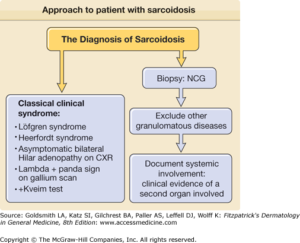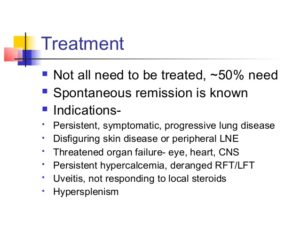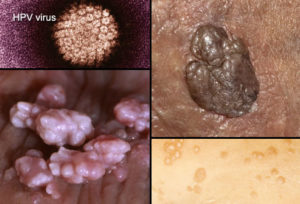Part III Sarcoidosis Awareness Month-Diagnosis, Staging, & Rx.
2020
How Sarcoidosis can be diagnosed:
- of the lungs, liver, skin, or other affected organs to check for granulomas
- Blood tests, including complete blood counts, to check hormone levels and to test for other conditions that may cause sarcoidosis
- Bronchoscopy, which may include rinsing an area of the lung to get cells or using a needle to take cells from the lymph nodes in the chest
- Chest X-ray to look for granulomas in the lungs and heart and determine the stage of the disease. Often, sarcoidosis is found because a chest X-ray is performed for another reason.
- Neurological tests, such as electromyography, evoked potentials, spinal taps, or nerve conduction tests, to detect problems with the nervous system caused by sarcoidosis
- Eye exam to look for eye damage, which can occur without symptoms in a person with sarcoidosis
- Gallium scan external link , which uses a radioactive material called gallium to look for inflammation, usually in the eyes or lymph nodes.
- High-resolution computed tomography (CT) scan to look for granulomas
- Magnetic resonance imaging (MRI) to help find granulomas. Learn more in our Chest MRI Health Topic.
- Positron electron tomography (PET) scan, a type of imaging that can help find granulomas
- Pulmonary function tests to check whether you have breathing problems
- Ultrasound to look for granulomas
There is a staging to Sarcoidosis:
Doctors use stages to describe the various imaging findings of sarcoidosis of the lung or lymph nodes of the chest. There are four stages of sarcoidosis, and they indicate where the granulomas are located. In each of the first three stages, sarcoidosis can range from mild to severe. This helps the doctor in deciding treatment for the patient. Stage IV is the most severe and indicates permanent scarring in the lungs.
- Stage I: Granulomas are located only in the lymph nodes.
- Stage II: Granulomas are located in the lungs and lymph nodes.
- Stage III: Granulomas are located in the lungs only.
- Stage IV: Pulmonary fibrosis.
Treatment for Sarcoidosis:
Remember there is no cure. The goal of treatment is remission, a state in which the condition is not causing problems. Not everyone who is diagnosed with sarcoidosis needs treatment. Sometimes the condition goes away on its own. Whether you need treatment—and what type you need—will depend on your signs and symptoms, which organs are affected, and whether those organs are working well; this is also where staging of the disease comes into play. Some people do not respond to treatment.
QUOTE FOR MONDAY:
“Sarcoidosis can occur in any organ, but it most commonly affects the lungs, lymph nodes and heart. Signs and symptoms of sarcoidosis vary depending on which organs are affected. Doctors don’t know the exact cause of sarcoidosis. While anyone can develop sarcoidosis, factors that may increase your risk include: age, sex, race and family history. Sometimes sarcoidosis causes long-term problems. Complications depend on the organ effected.”
MAYO CLINIC
QUOTE FOR THE WEEKEND:
“In 2008, Congress declared April as National Sarcoidosis Awareness Month to bring more attention to this rare, multisystem disease. Five years later, we are slowly but surely making progress, bothS in public awareness and in research of sarcoidosis. Purple is the color of the ribbon for sarcoidosis awareness.”
The Bernie Mac Foundation
Part I Sarcoidosis Awareness Month
Sarcoidosis (pronounced SAR-COY-DOE-SIS) is an inflammatory disease characterized by the formation of granulomas, tiny clumps of inflammatory cells, in one or more organs of the body. When the immune system goes into overdrive and too many of these clumps form, they can interfere with an organ’s structure and function. When left unchecked, chronic inflammation can lead to fibrosis, which is permanent thickening or scarring of organ tissue.
This disorder can affect almost any organ in the body, including the heart, skin, liver, kidneys, brain, sinuses, eyes, muscles, bones, and other areas. Sarcoidosis most commonly targets the lungs and the lymph nodes, which are an important part of the immune system. When it affects the lungs, it is called pulmonary sarcoidosis. Ninety percent or more of people diagnosed with the disease have lung involvement.
Doctors believe sarcoidosis results from the body’s immune system responding to an unknown substance, most likely something inhaled from the air.
General symptoms
For many people, sarcoidosis begins with these symptoms:
- Fatigue
- Fever
- Swollen lymph nodes
- Weight loss
Lung symptoms
Many patients with sarcoidosis experience lung problems, which may include:
- Persistent dry cough
- Shortness of breath
- Wheezing
- Chest pain
Skin symptoms
Some people who have sarcoidosis develop skin problems, which may include:
- A rash of red or reddish-purple bumps, usually located on the shins or ankles, which may be warm and tender to the touch
- Disfiguring sores (lesions) on the nose, cheeks and ears
- Areas of skin that are darker or lighter in color
- Growths under the skin (nodules), particularly around scars or tattoos
Eye symptoms
Sarcoidosis can affect the eyes without causing any symptoms, so it’s important to have your eyes checked. When eye symptoms do occur, they may include:
- Blurred vision
- Eye pain
- Severe redness
- Sensitivity to light
Heart symptoms
Cardiac sarcoidosis: A heart under attack
Signs and symptoms related to cardiac sarcoidosis may include:
- Chest pain
- Shortness of breath (dyspnea)
- Fainting (syncope)
- Fatigue
- Irregular heartbeats (arrhythmias)
- Rapid or fluttering heart beat (palpitations)
- Swelling caused by excess fluid (edema)
Stay tune for Part II tomorrow on Sardcoidosis Awareness Month!
QUOTE FOR FRIDAY:
” Dogs relieve stress. According to a study conducted in the 1980s by Aaron Katcher of the University of Pennsylvania and Alan Beck of Purdue, playing with a dog or even just petting a familiar dog lowers blood pressure and heart rate, slows breathing, and relaxes muscle tension almost immediately. Dogs are good for your heart. Literally. The “American Journal of Cardiology” published and researched. Dogs make us happy. In fact, even just looking at a dog can make you happier. A study in Japan in 2009 found that just staring into your dog’s eyes raises your level of oxytocin, also known as the “love hormone. Dogs make us want to take care of them. There must be a reason why so many people become virtually addicted to dog videos, and why puppies are so irresistible. ”
American Kennel Club AKC.org
QUOTE FOR WEDNESDAY:
“As human civilizations flourished, so did infectious disease. Large numbers of people living in close proximity to each other and to animals, often with poor sanitation and nutrition, provided fertile breeding grounds for disease. And new overseas trading routes spread the novel infections far and wide, creating the first global pandemics.
Three of the deadliest pandemics in recorded history were caused by a single bacterium, Yersinia pestis, a fatal infection otherwise known as the plague.
The Plague of Justinian arrived in Constantinople, the capital of the Byzantine Empire, in 541 CE. It was carried over the Mediterranean Sea from Egypt, a recently conquered land paying tribute to Emperor Justinian in grain. Plague-ridden fleas hitched a ride on the black rats that snacked on the grain.
The plague decimated Constantinople and spread like wildfire across Europe, Asia, North Africa and Arabia killing an estimated 30 to 50 million people, perhaps half of the world’s population.
The plague never really went away, and when it returned 800 years later, it killed with reckless abandon. The Black Death, which hit Europe in 1347, claimed an astonishing 200 million lives in just four years.
London never really caught a break after the Black Death. The plague resurfaced roughly every 20 years from 1348 to 1665—40 outbreaks in 300 years. And with each new plague epidemic, 20 percent of the men, women and children living in the British capital were killed.
Smallpox was endemic to Europe, Asia and Arabia for centuries, a persistent menace that killed three out of ten people it infected and left the rest with pockmarked scars. But the death rate in the Old World paled in comparison to the devastation wrought on native populations in the New World when the smallpox virus arrived in the 15th century with the first European explorers.
The indigenous peoples of modern-day Mexico and the United States had zero natural immunity to smallpox and the virus cut them down by the tens of millions.
“There hasn’t been a kill off in human history to match what happened in the Americas—90 to 95 percent of the indigenous population wiped out over a century,” says Mockaitis. “Mexico goes from 11 million people pre-conquest to one million.”
In the early- to mid-19th century, cholera tore through England, killing tens of thousands. The prevailing scientific theory of the day said that the disease was spread by foul air known as a “miasma.” But a British doctor named John Snow suspected that the mysterious disease, which killed its victims within days of the first symptoms, lurked in London’s drinking water.
While cholera has largely been eradicated in developed countries, it’s still a persistent killer in third-world countries lacking adequate sewage treatment and access to clean drinking water.”
History.com
TODAY’S CORONA WE WILL OVERCOME AND NOT AFFECTING OR KILLING THE AMOUNTS OF PREVIOUS PANDEMICS!
Check out more on history on striveforgoodhealth.com showing we will get through this strong and be back to normal soon!!
Pandemics in history and why NYC is the highiest count of Corona Virus!




Pandemics we have had in history and most of the people back than also got through it just like we will today with Corona VIrus. Unfortunately their were some deaths but the majority beat it and we will also. Keep in mind death carries many factors in causing it, past history or age (geriatric if not very young), low immunity (like a pt receiving chemo for cancer), lung or cardiac disease history. So this must be kept in mind.
Previous Pandemics in the United States: Reference is the CDC:
“1-1889-1890 Asiatic flu” or “Russian flu”, was a deadly influenza pandemic that killed about 1 million people worldwide. … For some time the virus strain responsible was conjectured to be Influenza A virus subtype H2N2. In the modern industrial age, new transport links made it easier for influenza viruses to wreak havoc. In just a few months, the disease spanned the globe, killing 1 million people. It took just five weeks for the epidemic to reach peak mortality.
The earliest cases were reported in Russia. The virus spread rapidly throughout St. Petersburg before it quickly made its way throughout Europe and the rest of the world, despite the fact that air travel didn’t exist yet.
2-1918-1920 Spanish Flu – influenza type A subtype H1N1 January 1918 to December 1920, The number of deaths was estimated to be at least 50 million worldwide with about 675,000 occurring in the United States.
3-1957-1958 Asian Flu Pandemic – (H2N2 virus) In Feb 1957 a new influenza A (H2N2) virus emerged in East Asia. It was first reported in Singapore in February 1957, Hong Kong in April 1957, and in coastal cities in the United States in summer 1957. The estimated number of deaths was 1.1 million worldwide and 116,000 in the United States.
4-1968-1969 Hong Kong Flu Influenza – a new influenza pandemic arose in Southeast Asia and acquired the sobriquet Hong Kong influenza on the basis of the site of its emergence to western attention. Once again, the daily press sounded the alarm with a brief report of a large Hong Kong epidemic in the Times of London.
A decade after the 1957 pandemic, epidemiologic communication with mainland China was even less efficient than it had been earlier. This new H3N2 influenza virus emerges to trigger another pandemic, resulting in roughly 100,000 deaths in the U.S. and 1 million worldwide. Most of those deaths are in people 65 and older. H3N2 viruses circulating today are descendants of the H3N2 virus that emerges in 1968.
5-1980s-HIV/AIDS – Americas.Since the first cases of acquired immunodeficiency syndrome (AIDS) were reported in 1981, infection with human immunodeficiency virus (HIV) has grown to pandemic proportions, resulting in an estimated 65 million infections and 25 million deaths (1,2). During 2005 alone, an estimated 2.8 million persons died from AIDS, 4.1 million were newly infected with HIV, and 38.6 million were living with HIV (2). HIV continues to disproportionately affect certain geographic regions.
6-2005-2012 Death Toll: 36 million
Cause: HIV/AIDS
First identified in Democratic Republic of the Congo in 1976, HIV/AIDS has truly proven itself as a global pandemic, killing more than 36 million people since 1981. Currently there are between 31 and 35 million people living with HIV, the vast majority of those are in Sub-Saharan Africa, where 5% of the population is infected, roughly 21 million people. As awareness has grown, new treatments have been developed that make HIV far more manageable, and many of those infected go on to lead productive lives. Between 2005 and 2012 the annual global deaths from HIV/AIDS dropped from 2.2 million to 1.6 million
CDC states “AIDS has claimed an estimated 35 million lives since it was first identified. HIV, which is the virus that causes AIDS, likely developed from a chimpanzee virus that transferred to humans in West Africa in the 1920s.”
7-2009-August 2010 – The most recent flu pandemic in the US, initially known as “swine flu,” occurred in 2009 with a novel influenza virus, H1N1, not previously identified in either animals or humans, per the CDC. The virus was actually first detected in the US, and spread quickly cross the US and the world. According to the CDC, between April 12, 2009 and April 10, 2010, there were 60.8 million cases, 274,304 hospitalizations, and 12,469 deaths (range: 8868-18,306) in the US due to the virus. The CDC also estimated that up to 575,400 people died worldwide.
According to the CDC, the 2009 flu pandemic primarily affected children and middle-aged adults (older adults had immunity, likely from a previous exposure to a similar H1N1 virus). And while the pandemic officially ended on August 10, 2010, the (H1N1)pdm09 virus continues to circulate as a seasonal flu virus, causing illness, hospitalization, and deaths worldwide every year.
Pandemics go back into 166 AD. Antonine Plague
Death Toll: 5 million
Cause: Unknown
Also known as the Plague of Galen, the Antonine Plague was an ancient pandemic that affected Asia Minor, Egypt, Greece, and Italy and is thought to have been either Smallpox or Measles, though the true cause is still unknown.
NOW CORONA VIRUS. CDC states:
In the USA:
Total cases: 525,704
Total deaths: 20,486
Jurisdictions reporting cases: 55 (50 states, District of Columbia, Guam, Puerto Rico, the Northern Mariana Islands, and the U.S. Virgin Islands)
Why NYC the worst with Corona Virus (COVID 19) look up on the internet who is the filthiest city in America if not the top 5, look up the population on NYC in the 5 boroughs, the amount of low class income people in NYC, the amount of traveling in and out of NYC, Queens alone has a national airport, the peer with traveling around the world on cruise ships. Also NYC is a sanctuary city. Their are many factors involved and all these play a role.
We will get through this and unfortunately pandemics repeat in history!




QUOTE FOR TUESDAY:
“ Genital warts are a common sexually transmitted infection. They can appear on the genitals, in the pubic area or in the anal canal. In women, genital warts can grow on the vulva, the walls of the vagina, the area between the external genitals and the anus, the anal canal, and the cervix.”.
MAYO CLINIC
What are genital warts?
Genital warts (or condylomata acuminata, venereal warts, anal warts and anogenital warts)
Genital warts affect both men and women and can occur at any age.
Most patients with genital warts are between the ages of 17-33 years. Genital warts are highly contagious. There is high risk of getting the infection from a single sexual contact with someone who has genital warts.
In children younger than three years of age, genital warts are thought to be transmitted by nonsexual methods such as direct manual contact. Nevertheless, the presence of genital warts in children should raise the suspicion for sexual abuse.
Up to 20% of people with genital warts will have other sexually transmitted diseases (STDs).
Most genital warts are caused by two specific types of the virus (HPV-6 and -11), and these HPV types are considered “low risk,” meaning they have a low cancer-causing potential. Other HPV types are known causes of premalignant changes and cervical cancers in women. HPV16, one of the “high-risk” types, is responsible for about 50% of cervical cancers. HPV types 16, 18, 31, and 45 are other known “high risk” virus types. High-risk HPV types are also referred to as oncogenic HPV types. HPV is believed to cause 100% of cases of cervical cancer..
Genital warts are caused by the human papillomavirus (HPV). Over 100 types of HPVs have been identified; about 40 of these types have the potential to infect the genital area.
Most genital warts are caused by two specific types of the virus (HPV-6 and -11), and these HPV types are considered “low risk,” meaning they have a low cancer-causing potential. Other HPV types are known causes of premalignant changes and cervical cancers in women. HPV16, one of the “high-risk” types, is responsible for about 50% of cervical cancers. HPV types 16, 18, 31, and 45 are other known “high risk” virus types. High-risk HPV types are also referred to as oncogenic HPV types. HPV is believed to cause 100% of cases of cervical cancer.
The viral particles are able to penetrate the skin and mucosal surfaces through microscopic abrasions in the genital area, which occur during sexual activity. Once cells are invaded by HPV, a latency (quiet) period of months to years may occur, during which there is no evidence of infection.
Genital warts are indirectly associated with use of birth control pills due to increased sexual contact without the use of barrier protection, multiple sex partners, and having sex at an early age.
The size may range from less than one millimeter (1 mm = 0.039 inches) across to several square centimeters (1 cm = 0.39 inches) when many warts join together.
Rarely, bleeding or urinary obstruction may be the initial problem when the wart involves the urethral opening (the opening where urine exits the body.)
There may be a history of previous or concurrent sexually transmitted diseases (STDs).In men, genital warts can infect the urethra, penis, scrotum, and rectal area. The warts can appear as soft, raised masses with a surface that can be smooth (on the penile shaft) or rough with many fingerlike projections (anal warts). Others may appear pearly, cauliflower-like, or rough with a slightly dark surface. Most lesions are raised, but some may be flat with only slight elevation above the skin surface. Sometimes lesions may be hidden by hair or in the inner aspect of the uncircumcised foreskin in males.
Diagnosis:
It is often based on findings from the history and appearance of the genital warts. Magnification of the area (colposcopy) using a scope may be necessary to see the lesions. In females, a colposcope may be used to look for lesions in the vaginal canal and on the cervix. A biopsy can be performed if the lesion appears unusual or recurs after treatment. Because genital warts essentially have no symptoms other than their appearance, there is little need for home treatment. It is important, however, to recognize that the warts exist. Be careful to prevent transmission to a sexual partner.
Treatment:
#1 before even getting genital herpes and stick PREVENTION!! Never get them.
Cryotherapy: This technique freezes the wart using liquid nitrogen or a “cryoprobe.” It is an excellent first-line treatment because response rates are high with few side effects.
Electrodesiccation: This technique uses an electric current to destroy the warts. It can be done in the office with local anesthesia. Of note, the resulting smoke plume may be infectious.
Surgery in some cases removing the warts.
Complete the necessary treatment as outlined by your health care practitioner
There is also alternative treatments:
*Types of medical creams prescribed and even OTC. Again please with the all topical creams it is vital to complete the treatment as ordered by your doctor!
*Laser treatment – This treatment is used for extensive or recurrent genital warts. It may require local, regional, or general anesthesia. The laser physically destroys the HPV-induced lesion. Disadvantages include high cost, increased healing time, scarring, and potentially infectious viral particles in the air caused by the laser plume (hydrodynamics).
There is no single effective cure for removal of genital warts. A number of treatment options exist; however, no treatment is 100% effective in eliminating warts and preventing them from coming back in all patients. It also is not possible to eliminate infection with human papillomavirus (HPV) once it has occurred. Genital warts may go away on their own in about 10% to 20% of people over a period of three to four months.
Things you should also know:
- Because the warts themselves are infectious, avoid touching them. Do not pick or squeeze the warts.
- Take the necessary precautions to prevent trauma to the area, which can result in bleeding.
- Special laboratory tests can also be used to confirm the presence of HPV infection.
- A routine Pap smear should always be done in order to look for evidence of HPV infection and abnormal cells on the cervix.
- Sometimes, lesions are only visible with an enhancing technique called acetowhitening. This technique involves the application of 5% acetic acid solution to the area of suspicion for about 5-10 minutes. Infected areas will turn white.
- In women, genital warts have a similar appearance and usually occur in the moist areas of the labia minora and vaginal opening. Lesions visible on the outer genitals warrant a thorough examination of the vaginal canal, cervix, and anorectal area. Most vaginal warts occur without symptoms.
- Rarely, women may experience bleeding after sexual intercourse, itching, or vaginal discharge.
- Specific descriptions
- Warts in more than one area are common.
- Men and women with genital warts will often complain of painless bumps, itching, and discharge.
- Signs or genital warts: First know although genital warts are painless, they may be bothersome because of their location, size, or due to itching.
- Generally, about two-thirds of people who have sexual contact with a partner who has genital warts develop them within three months.
- Common warts are not the same as genital warts and are caused by different HPV types that infect the skin.



